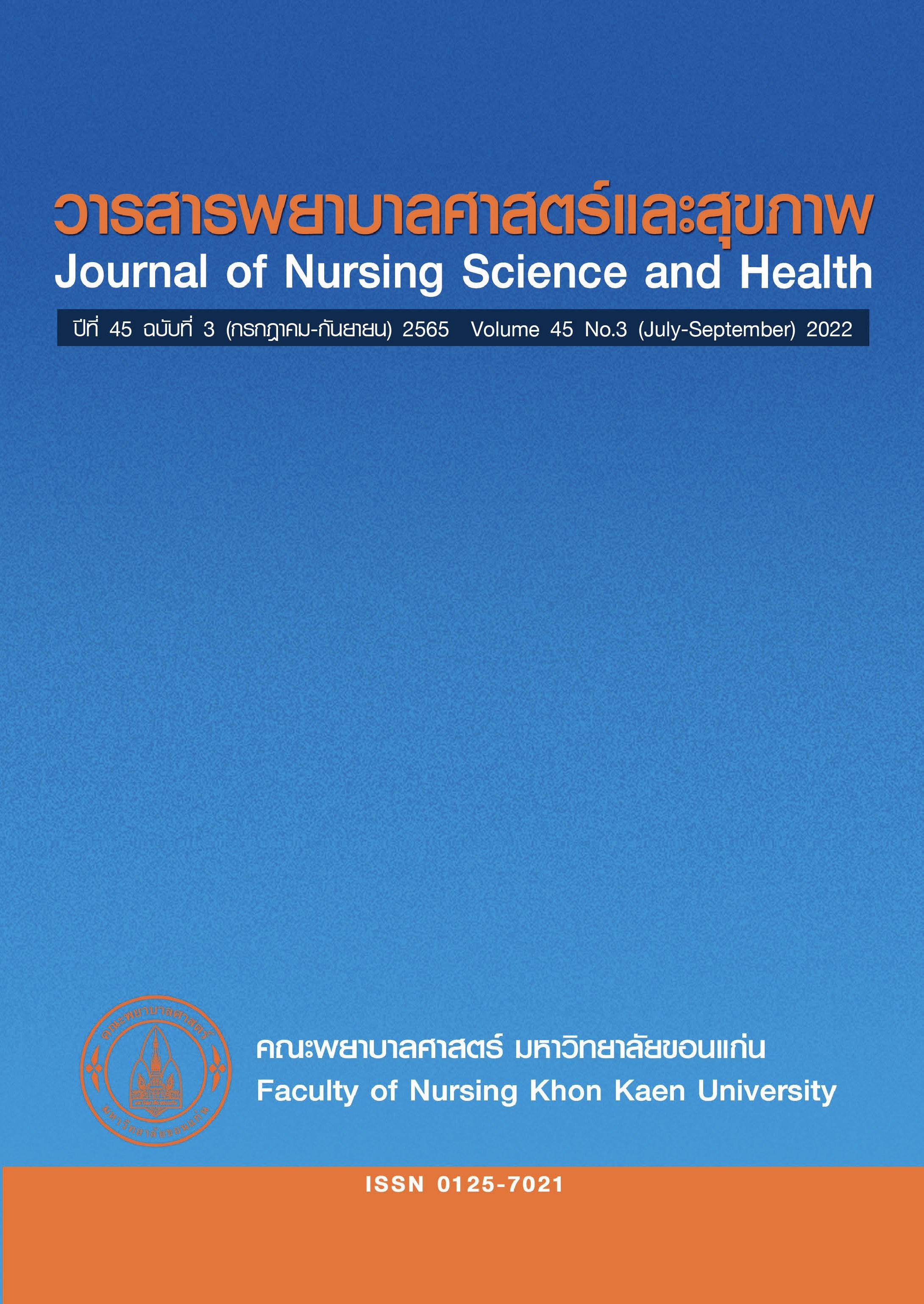การปรับตัวให้นอนพักได้บ้างของผู้ป่วยเด็กวัยเรียนโรคมะเร็งเม็ดเลือดขาว ระหว่างที่ได้รับเคมีบำบัด
คำสำคัญ:
เคมีบำบัด , การปรับตัว , การนอน , โรคมะเร็งเม็ดเลือดขาว , เด็กวัยเรียนบทคัดย่อ
ผู้ป่วยเด็กวัยเรียนโรคมะเร็งเม็ดเลือดขาวต้องได้รับการรักษาด้วยเคมีบำบัด ทำให้เกิดความไม่สุขสบายหลายอย่าง รวมไปถึงการมีปัญหาการนอนซึ่งส่งผลต่อสุขภาพและการตอบสนองต่อการรักษา ปัจจุบันยังไม่พบการศึกษาที่ชี้เฉพาะเกี่ยวกับปัญหาการนอนและวิธีการจัดการกับปัญหาการนอนของผู้ป่วยเด็กกลุ่มนี้ การศึกษาครั้งนี้มีวัตถุประสงค์เพื่อบรรยายปัญหาการนอนและการจัดการกับปัญหาการนอนของผู้ป่วยเด็กวัยเรียนโรคมะเร็งเม็ดเลือดขาวระหว่างที่ได้รับเคมีบำบัด ซึ่งเป็นส่วนหนึ่งของงานวิจัยเรื่องการจัดการกับปัญหาการนอนของผู้ป่วยเด็กวัยเรียนโรคมะเร็งเม็ดเลือดขาวระหว่างได้รับเคมีบำบัดโดยใช้วิธีวิจัยเชิงคุณภาพ ผู้ให้ข้อมูลคือผู้ป่วยเด็กวัยเรียนโรคมะเร็งเม็ดเลือดขาว อายุ 8–12 ปี จำนวน 10 ราย ที่ได้รับการรักษาด้วยเคมีบำบัดตั้งแต่ระยะที่ 2 เป็นต้นไป ณ สถาบันสุขภาพเด็กแห่งชาติมหาราชินี เก็บข้อมูลโดยการสัมภาษณ์เชิงลึก และนำข้อมูลมาวิเคราะห์แบบแก่นสาระ
ผลการวิจัย พบว่า “การปรับตัวให้นอนพักได้บ้าง” เป็นประเด็นหลักที่สะท้อนให้เห็นว่าผู้ป่วยเด็กวัยเรียนโรคมะเร็งเม็ดเลือดขาวยังมีปัญหาการนอน โดยผู้ป่วยเด็กต้องประสบกับการนอนที่ต้องหลับ ๆ ตื่นๆ การนอนที่ไม่ต่อเนื่อง ตื่นแล้วไม่สามารถนอนต่อได้ ซึ่งผู้ป่วยเด็กมีวิธีการจัดการกับปัญหาการนอนที่เกิดขึ้นด้วยตนเองโดยการงีบหลับเป็นช่วงสั้น ๆ ช่วงระหว่างการดำเนินชีวิตประจำวัน หรือหาวิธีการคลายความร้อนในร่างกายซึ่งเป็นผลที่เกิดจากเคมีบำบัดเพื่อช่วยให้ตนเองหลับได้ เช่น การเปิดเครื่องปรับอากาศ เปิดพัดลม หรืออาบน้ำ แต่อย่างไรก็ตาม วิธีการจัดการเหล่านี้ยังไม่สามารถชดเชยต่อการนอนหลับให้เพียงพอได้ แสดงให้เห็นว่าผู้ป่วยเด็กวัยเรียนโรคมะเร็งเม็ดเลือดขาวยังคงมีปัญหาการนอนและไม่สามารถจัดการกับปัญหาการนอนได้ด้วยตนเอง พยาบาลเด็กสามารถนำผลที่ได้จากการศึกษาครั้งนี้ไปใช้เป็นข้อมูลพื้นฐานในการพัฒนาหรือสร้างแนวทางปฏิบัติการพยาบาลสำหรับผู้ป่วยเด็กวัยเรียนโรคมะเร็งเม็ดเลือดขาวที่ได้รับเคมีบำบัดที่มีปัญหาการนอน รวมทั้งการวิจัยต่อไปในอนาคตได้
เอกสารอ้างอิง
Baggott CR, editor. Nursing care of children and adolescents with cancer. Philadelphia : WB Saunders Co.;2002: p.66-70.
Pui CH, Evans WE. Treatment of acute lymphoblastic leukemia. NEJM 2006;354(2):166-78. doi: 10.1056/NEJMra052603
Kaleyias J, Manley P, Kothare SV. Sleep disorders in children with cancer. Semin Pediatr Neurol 2012;19(1):25-34. doi:10.1016/j.spen.2012.02.013
Kotagal S, Chopra A. Pediatric sleep-wake disorders. Neurologic Clinics 2012;30(4):1193-212. doi:https://doi.org/10.1016/j.ncl.2012.08.005
Redeker N, McEnany GP, editors. Sleep disorders and sleep promotion in nursing practice. New York: Springer Publishing Company;2011:19-32.
Walter LM, Nixon GM, Davey MJ, Downie PA, Horne RS. Sleep and fatigue in pediatric oncology: A review of the literature. Sleep Medicine Reviews 2015;24:71-82. doi: 10.1016/j.smrv.2015.01.001
Wanich P. Influences of stress, pain, and nursing care activities on sleep quality in children with cancer receiving chemotherapy [thesis]. Songkla: Prince of Songkla University;2018. (in Thai)
Pharnit J, Chaiyawat W. Illness experience of school age patients with leukemia. JTNMC 2007;22(3):40-54. (in Thai)
Daniel LC, Schwartz LA, Mindell JA, Tucker CA, Barakat LP. Initial validation of the sleep disturbances in pediatric cancer model. Journal of Pediatric Psychology 2016;41(6):588-99. doi:10.1093/jpepsy/jsw008.
van Litsenburg RR, Huisman J, Hoogerbrugge PM, Egeler RM, Kaspers GJ, Gemke RJ. Impaired sleep affects quality of life in children during maintenance treatment for acute lymphoblastic leukemia: An exploratory study. Health and Quality of Life Outcomes 2011;9(1):25. doi:10.1186/1477-7525-9-25
Patoomwan A. Living with childhood cancer in Thai families: Stories of struggling with uncertainty [dissertation]. San Francisco (PO): University of California;2001.
Punthmatharith B, Buddharat U, Wattanasit P. Quality of life and factors influencing quality of life of cancer children in southern Thailand. Songklanagarind Medical Journal 2008;26(5):501-11. (in Thai)
Khamchan P, Punthmatharith B. Coping of children with cancer undergoing treatment. Songklanagarind J Nurs 2020;40(3):82-98. (in Thai)
Saengthong W, Howharn C, Maneesri R. The effects of a preparation program on self-care behaviors of school-aged children with acute leukemia under chemotherapy during the initial stage of treatment. SCNJ 2020;7(1):158-68. (in Thai)
Linder LA, Christian BJ. Nighttime sleep characteristics of hospitalized school-age children with cancer. Journal for Specialists in Pediatric Nursing 2013;18(1):13-24. doi: 10.1111/ jspn.12005
Braun V, Clarke V. Using thematic analysis in psychology. Qual Res Psychol 2006;3:77–101. doi:10.1191/1478088706qp063oa.
Berger AM, Parker KP, Young-McCaughan S, Mallory GA, Barsevick AM, Beck SL, et al. Sleep wake disturbances in people with cancer and their caregivers: State of the science. Oncol Nurs Forum 2005;32(6):E98-126. doi: 10.1188/05.ONF.E98-E126
Setoyama A, Ikeda M, Kamibeppu K. Objective assessment of sleep status and its correlates in hospitalized children with cancer: Exploratory study. Pediatrics International 2016;58:842-9. doi:10.1111/ped.12927
Hooke MC, Linder LA. Symptoms in children receiving treatment for cancer—part I: Fatigue, sleep disturbance, and nausea/vomiting. J Pediatr Oncol Nurs 2019;36(4):244-61. doi.org/10.1177/1043454219849576
Davidson JR, MacLean AW, Brundage MD, Schulze K. Sleep disturbance in cancer patients. Soc Sci Med 2002;54(9):1309-21. doi: 10.1016/s0277-9536(01) 00043-0
Paavonen EJ, Aronen ET, Moilanen I, Piha J, Räsänen E, Tamminen T, et al. Sleep problems of school-aged children: A complementary view. Acta Paediatrica 2000;89(2):223-8. doi: 10.1080/080352500750028870
Siriwannabut P. Development psychological theory. 6th ed. Bangkok: Chulalongkorn University Press;2013. (in Thai)
Nowell LS, Norris JM, White DE, Moules NJ. Thematic analysis: Striving to meet the trustworthiness criteria. Int J Qual Methods 2017;16(1):1-13. doi: 10.1177/1609406917733 847
Owens JA, Spirito A, McGuinn M, Nobile C. Sleep habits and sleep disturbance in elementary school-aged children. J Dev Behav Pediatr 2000;21(1):27-36. doi: 10.1097/ 00004703-200002000-00005
Narongsak T, Sanguanvichaikul T, Trisithivanij V. Sleep and sleep hygiene: Review article.
J Somdet Chaopraya Inst Psychiat 2020;14(2):69-85. (in Thai)
Lewandowski AS, Ward TM, Palermo TM. Sleep problems in children and adolescents with common medical conditions. Pediatric Clinics 2011;58(3):699-713. doi:10.1016/j.pcl. 2011.03.012
Mindell JA, Owens JA. A clinical guide to pediatric sleep: Diagnosis and management of sleep problems. Upper Saddle River: NJ : Lippincott Williams & Wilkins;2015.
Thammaviphate S, Treenai S. The unspecified and unrecognized sleep problems in school-age patients with leukemia. RTNNMDjournal 2021;48(1):128-41. (in Thai)
Colgan S. Therapeutic touch: Integrative review and meta-analysis. Chisinau, Republic of Moldova: LAP LAMBERT Academic Publishing GmbH & Co. KG; 2011:17-32.
Russell KB, Merz EL, Reynolds K, Schulte F, Tomfohr-Madsen L. Sleep disturbances in survivors of pediatric acute lymphoblastic leukemia and their siblings. Journal of Pediatric Psychology 2020;45(7):707–16. https://doi.org/10.1093/jpepsy/jsaa043
ดาวน์โหลด
เผยแพร่แล้ว
รูปแบบการอ้างอิง
ฉบับ
ประเภทบทความ
สัญญาอนุญาต
ลิขสิทธิ์ (c) 2022 วารสารพยาบาลศาสตร์และสุขภาพ

อนุญาตภายใต้เงื่อนไข Creative Commons Attribution-NonCommercial-NoDerivatives 4.0 International License.
วารสารพยาบาลศาสตร์และสุขภาพเป็นเจ้าของลิขสิทธิ์ในการเผยแพร่ผลงานที่ตีพิมพ์ห้ามผู้ใดนำบทความที่ได้รับการตีพิมพ์ในวารสารพยาบาลศาสตร์และสุขภาพไปเผยแพร่ในลักษณะต่าง ๆ ดังนี้ การนำบทความไปเผยแพร่ออนไลน์ การถ่ายเอกสารบทความเพื่อกิจกรรมที่ไม่ใช่การเรียนการสอน การส่งบทความไปตีพิมพ์เผยแพร่ที่อื่น ยกเว้นเสียแต่ได้รับอนุญาตจากวารสารพยาบาลศาสตร์และสุขภาพ



